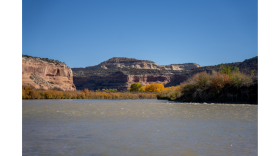-
The democratic senator and gubernatorial candidate joins other state leaders in supporting a 2026 ballot measure that would allow Colorado to redraw its congressional boundaries.
-
Eighteen cattle ranchers in the Mountain West region are partnering with a carbon credit company to make their land healthier and get extra revenue.
-
Ranchers in Colorado are frustrated by the Trump administration's recent decisions on beef imports and say they are creating uncertainty in the market that's bad for business.
-
Flock has been in use in Durango since 2023. The cameras capture images of each passing car, including its license plate number, make, model, color, and even bumper stickers and dents. AI then catalogs all this information, creating a searchable database for officers.
-
Ten Utah youth are suing the state over its issuance of permits for fossil fuels, which they say violates their rights to life, safety, and health. All of the plaintiffs reside in counties that have received an "F" grade from the American Lung Association due to their poor air quality. It's the latest in a series of climate lawsuits happening around the country.
-
A consumer advocacy group is asking top insurance companies to adopt a list of nine protections aimed at increased transparency and fairness.
-
New research shows that mountain regions around the world are warming faster than the lowlands below them. Scientists say that could have big consequences for the Mountain West, where communities rely on snow and ice for their water supply.
-
The nonpartisan Center for American Progress found that 31 national monuments are at risk of having protections reduced or revoked under the Trump administration. But that would jeopardize some of the water on those landscapes, which provide drinking water for millions of people.
-
Colorado has been fighting Aquatic Nuisance Species or ANS for years. Aquatic invasives are often small unremarkable invertebrates; it isn't obvious how much damage they can cause to native environments, human infrastructure, and biodiversity across the West.
-
In December 2024, a rupture on an Enterprise Products pipeline on tribal and county land near Durango caused tens of thousands of gallons of refined gasoline to spill onto Florida Mesa. Now, the Environmental Protection Agency is getting involved in the cleanup process.

Play Live Radio
Next Up:
0:00
0:00
Available On Air Stations










